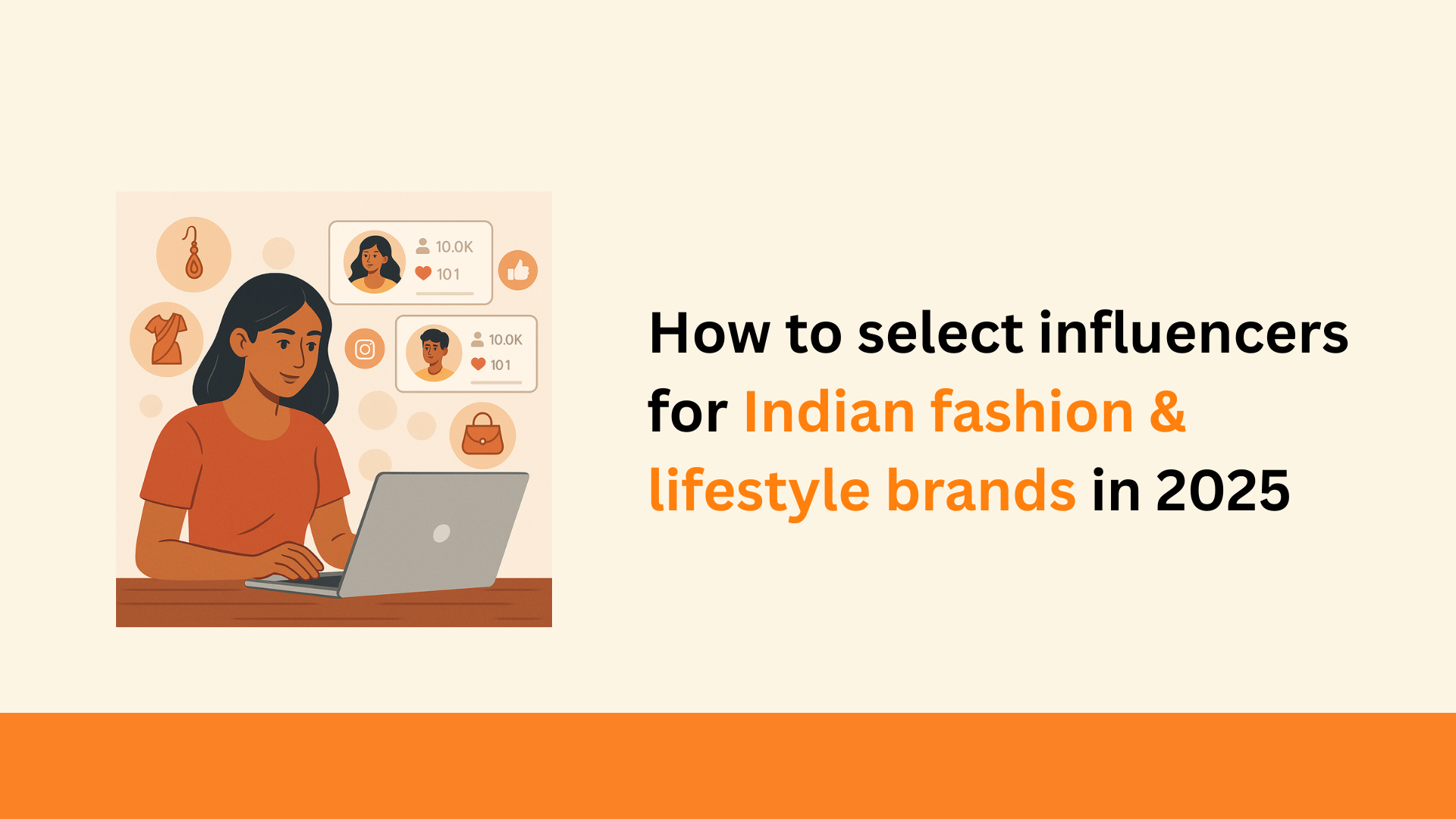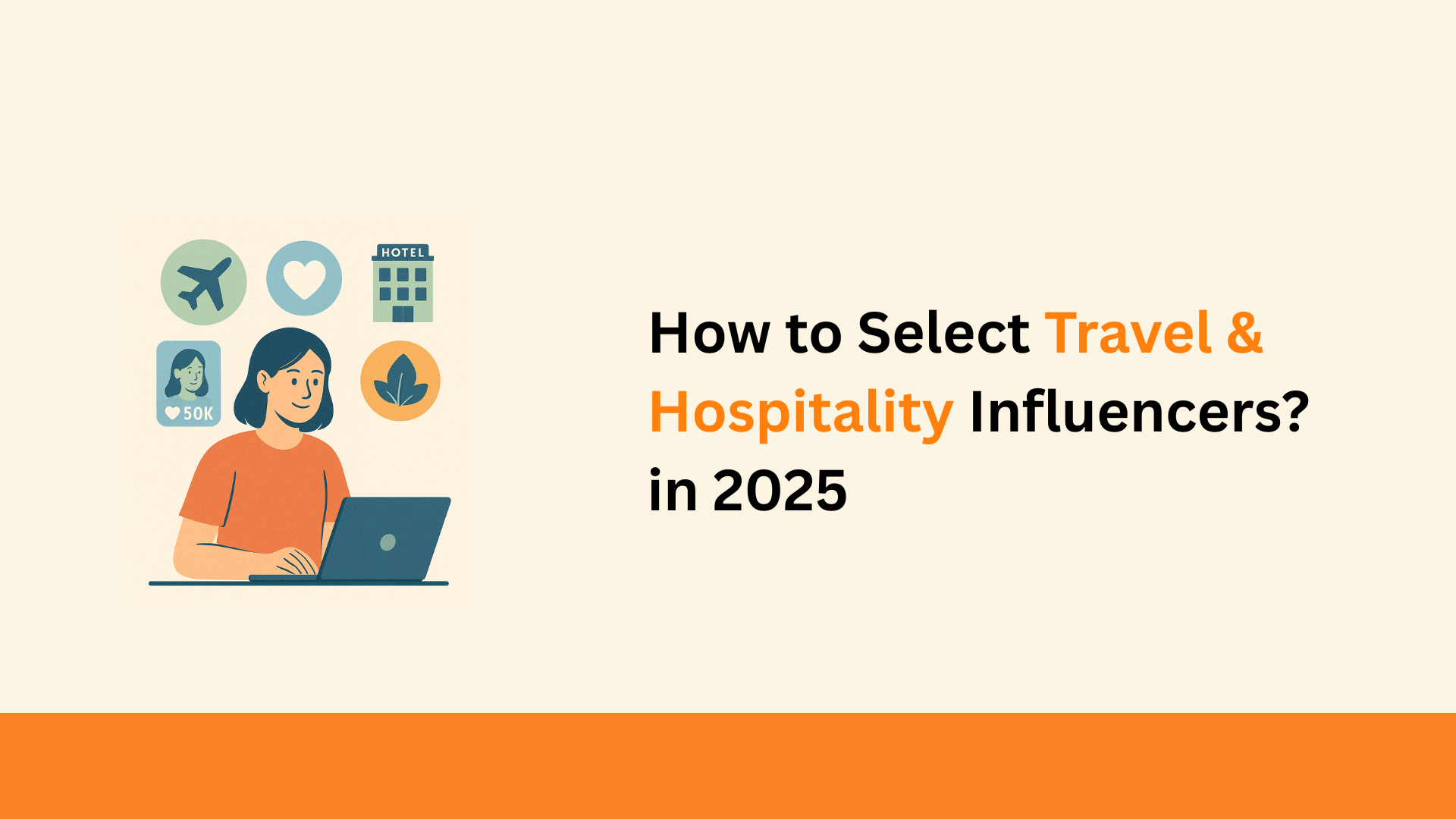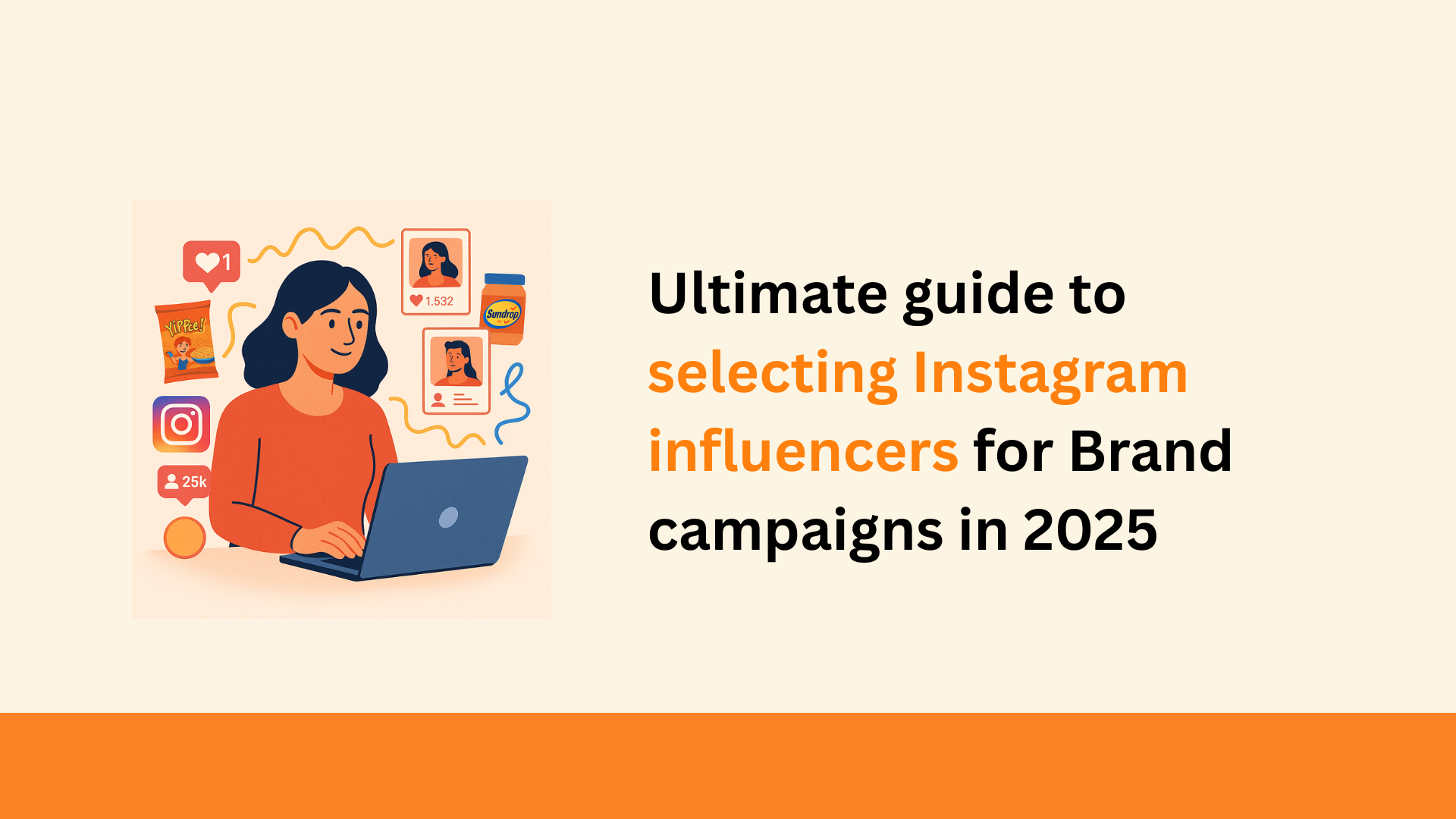TL;DR
- Fashion is identity-driven in India, with creators spanning luxury, thrift, desi-chic, and conscious style segments
- Creator fit matters more than follower count when selecting fashion influencers
- Different fashion categories (luxury apparel, fast fashion, and sustainable fashion) require specific influencer personalities
- Platform-specific strategies (Instagram Reels vs YouTube Shorts) dramatically impact collaboration success
Imagine launching your new ethnic fusion collection into the crowded Indian fashion market. You’ve got stunning designs, but in a space where 78% of fashion purchases are influenced by social media, your brand visibility depends on picking the right creators.
But here’s the challenge: with over 100,000 fashion influencers in India alone, how do you find the perfect match for your brand’s unique style and values?
Most fashion brands face a familiar struggle – selecting creators based on reach alone, only to discover their audience doesn’t convert. Or worse, partnering with influencers whose aesthetics clash with their brand identity.
That’s why we built this comprehensive guide. Born from our experience helping top Indian fashion houses connect with their ideal creator partners, it’s your roadmap to influencer selection that drives both brand impact and sales conversions.
The proof?
Fashion brands using strategic influencer selection see 4.5x higher engagement and 67% better ROI on their campaigns.
Ready to build your own?
Let’s explore how to select influencers who truly align with your fashion brand’s identity, aesthetic, and consumer values across India’s diverse style landscape.
Choosing the right fashion influencers for your brand
The Indian fashion landscape is a vibrant tapestry of personal expression. From high-end luxury to conscious consumption, from traditional ethnic wear to Gen Z thrift finds, each segment speaks to different values and aspirations.
Fashion creators vary dramatically by tone and style preference:
- Luxury curators: Showcase premium brands with polished, aspirational content
- Thrift champions: Celebrate sustainable style and budget-friendly finds
- Conscious creators: Focus on ethical production and slow fashion
- Desi-chic influencers: Blend traditional Indian elements with contemporary trends
- Gen Z style experimenters: Push boundaries with bold, trend-setting looks
When selecting influencers, the key is aligning with your brand’s core style, whether that’s experimental, heritage, aspirational, or comfort-led.
What makes influencer selection even more crucial in India is the cultural diversity. A creator who resonates in cosmopolitan Mumbai might not connect with audiences in tier-2 cities like Jaipur or Lucknow, where fashion sensibilities can differ significantly.
The Cultural Intersection in Indian Fashion Influencer Marketing
India’s fashion scene is uniquely positioned at the intersection of traditional heritage and global trends. This cultural nuance creates distinct influencer categories that brands must understand:
- Fusion Fashion Advocates: These creators excel at blending traditional Indian elements with contemporary styles. They appeal to the modern Indian consumer who values cultural roots while embracing global trends.
- Regional Style Specialists: With India’s diverse regional fashion traditions, these influencers focus on specific cultural styles from Bandhani in Gujarat to Kanjeevaram in Tamil Nadu. They connect deeply with audiences who prioritize cultural authenticity.
- Wedding Season Specialists: In a country where the wedding industry is valued at $50 billion annually, these influencers focus exclusively on bridal wear, groom styling, and wedding guest attire across various cultural traditions.
- Festival Fashion Curators: With India’s year-round festival calendar, these creators specialize in occasion-specific styling for celebrations like Diwali, Holi, Eid, and regional festivals.
Understanding these cultural dimensions helps brands select influencers who can authentically represent both tradition and innovation in ways that resonate with specific regional and cultural demographics.
Why Creator Fit > Follower Count
The biggest mistake fashion brands make? Choosing influencers based solely on follower count rather than style alignment.
A smaller creator whose aesthetic perfectly mirrors your brand identity will deliver far better results than a mega-influencer whose audience doesn’t match your target demographic.
Here’s your ultimate influencer selection checklist:
- Do they style your product category well?
- Review their past content featuring similar items (bags, ethnic wear, accessories)
- Assess if their styling approach showcases your products’ best features
- Does their audience match your price point?
- Look at engagement on posts featuring products at your price range
- Check if comments indicate purchase intent for your bracket
- Is their content authentic?
- Ensure they post a healthy mix of branded and unbranded fashion content
- Verify their engagement rate against industry benchmarks (7-9% is excellent)
Do they drive action?
- Check if their comments section consistently shows “Where is this from?” questions
- Look for evidence of conversion in previous brand collaborations
The engagement quality matrix
Beyond basic engagement metrics, successful fashion brands are now analyzing what we call the “Engagement Quality Matrix”, the types of interactions that truly indicate commercial intent:
- Save rate: Posts with high save rates (above 8%) indicate strong style inspiration value
- Comment sentiment: Comments expressing shopping intent (“Need this!” “Where can I buy?”) versus general admiration
- Follower shopping behavior: Evidence that the creator’s audience actively shops based on recommendations
- Conversation rate: How many comments lead to meaningful conversations about the product
According to Qoruz’s data, Indian fashion influencers with medium-sized followings (25 K- 100 K) but high-quality engagement matrices deliver 3.2x better conversion rates than larger influencers with generic engagement.
Match creator type to your fashion category
Not all fashion influencers are created equal. Different categories require specific creator personalities to maximize impact. Here’s a quick-reference table for finding your perfect match:
| Fashion Category | Ideal Influencer Type | Why They Work | Red Flags |
| Luxury Apparel | High-fashion editorial creators with a minimalist aesthetic | Sophisticated audience with higher spending power | Over-sponsored feed with mismatched brand values |
| Fast Fashion D2C | Relatable Gen Z stylists with frequent outfit posts | Young audience seeking affordable trend cycles | Poor styling skills or inconsistent aesthetic |
| Sustainable Fashion | Minimalist or conscious creators focusing on quality | Environmentally aware followers who prioritize ethics | History of promoting fast fashion brands |
| Ethnic Wear | Cultural curators with an appreciation for craftsmanship | Audience interested in traditional meets contemporary | Inexperienced in styling ethnic pieces authentically |
| Lifestyle Accessories | Flatlay specialists with strong visual composition | Detail-oriented followers who notice accessories | Over-filtered product features that misrepresent colors |
New ceator categories revolutionizing fashion marketing
Beyond traditional fashion influencers, several specialized creator categories are emerging in India’s digital landscape:
- OOTD (Outfit of the Day) specialists: These creators post daily outfit inspirations with consistent aesthetics and styling approaches. They excel at showing versatility and everyday wearability.
- Fashion technology reviewers: Focused on the intersection of fashion and technology, these creators review innovations like sustainable fabrics, smart accessories, and digital fashion experiences.
- Size-Inclusive style experts: With India’s growing body positivity movement, these influencers specialize in fashion for diverse body types, providing styling tips that transcend standard sizing.
- Budget fashion hackers: These creators specialize in finding and styling affordable alternatives to luxury trends, appealing to value-conscious consumers.
- Fashion sustainability educators: Beyond just promoting sustainable brands, these creators educate audiences about fabric choices, production ethics, and conscious consumption.
Identifying which specialized category aligns with your brand positioning can dramatically enhance campaign relevance and performance.
Platform-specific nuances in fashion collabs
Platform selection dramatically impacts your fashion campaign’s success. Each platform serves different content formats, audience demographics, and engagement patterns.
- Instagram remains the fashion powerhouse, with Reels driving 2.5x higher engagement than static posts for Indian fashion brands. Outfit transitions, styling tips, and behind-the-scenes content perform exceptionally well here.
- Pinterest has become a growing force for fashion discovery in India, with 67% of users using it to find style inspiration. Look for creators who excel at creating visually striking, vertically-oriented content.
- YouTube shorts is gaining traction for detailed styling tutorials and “Get Ready With Me” content, especially among tier-2 and tier-3 city audiences.
Content format strategies by platform
For maximum impact, tailor your influencer briefs to these platform-specific content formats:
Instagram strategy:
- Reels: 15-30 second outfit transitions set to trending music
- Stories: Behind-the-scenes styling process and clickable product tags
- Carousel Posts: Multiple styling options with a single item
- IGTV: Detailed styling tutorials or collection walkthroughs
YouTube strategy:
- Shorts: Quick styling tips under 60 seconds
- Long-form: “Shop With Me” or detailed product reviews
- Hauls: Seasonal collection reviews with styling suggestions
- Lookbooks: Thematic fashion stories with narrative structure
Pinterest strategy:
- Idea Pins: Step-by-step styling tutorials
- Standard Pins: Outfit inspiration with detailed descriptions
- Collections: Curated boards around specific themes or occasions
- Shopping Pins: Direct product links with styling context
The conversion path also varies by platform. Instagram drives immediate impulse purchases, YouTube influences consideration for higher-value items, while Pinterest creates longer-term aspiration and discovery.
Seasonal campaign strategies for Indian fashion
India’s fashion calendar revolves around distinct seasonal moments that require specialized influencer approaches:
Wedding season campaigns (November-February, June-July)
During India’s prime wedding seasons, partner with:
- Bridal fashion specialists with strong wedding community engagement
- Multi-outfit content creators who showcase complete wedding wardrobes
- Wedding photographers who include fashion in their content mix
Festival season (August-November)
During India’s festival season:
- Partner with creators who showcase the perfect balance of traditional and modern
- Focus on family-oriented influencers who capture a multi-generational style
- Prioritize creators with strong regional cultural connections
Summer fashion (March-June)
For summer collections:
- Collaborate with travel-focused fashion creators showcasing vacation styles
- Resort wear specialists who create aspirational yet accessible content
- Creators specializing in comfort-focused, heat-appropriate styling
Launch collections (Year-round)
For new collection launches:
- Consider exclusive preview access to select micro-influencers
- Pair with fashion industry insiders for credibility
- Create tiered launch strategies with different creator categories for each phase
Why platforms like Qoruz make fashion creator vetting smarter
Manual influencer discovery simply can’t scale for fashion brands targeting India’s diverse market segments. Tools like Qoruz provide data-backed matches based on:
- Style theme analysis: Finding creators whose aesthetic aligns with your brand vision
- Audience composition: Matching creators whose followers match your target demographic
- Cultural relevance: Identifying influencers with authentic connections to specific regions
- Engagement quality: Measuring meaningful interactions beyond surface metrics
The platform also helps brands identify bilingual creators who can bridge language barriers, essential in India’s multilingual market, where connecting in regional languages can increase engagement by up to 58%.
FAQs
- How do I choose influencers for a fashion brand?
Select influencers whose aesthetic and audience align with your brand identity. Review their styling ability for your specific product category, audience demographics, engagement quality, and past brand collaboration success.
- Should fashion brands focus on nano or macro creators?
It depends on your campaign goals. Nano influencers (1K-10K followers) typically deliver 5x higher engagement rates and stronger community trust, while macro influencers offer broader reach. Most successful Indian fashion brands use a strategic mix of both.
- What platform works best for fashion influencer campaigns?
Instagram leads for fashion marketing in India, with 82% of campaigns utilizing the platform. However, YouTube drives stronger purchasing decisions for higher-ticket items, while Pinterest excels for discovery and aspiration.
- How do I find influencers who match my brand aesthetic?
Use tools like Qoruz to filter creators by visual style, content themes, and audience demographics. Look beyond metrics to analyze the qualitative aspects of their content that match your brand’s visual language.
- What tools help with lifestyle influencer selection?
Qoruz provides specialized data for fashion and lifestyle brands, including aesthetic analysis, audience affinity matching, and engagement quality assessment. These features help identify creators whose content naturally aligns with your brand positioning.



